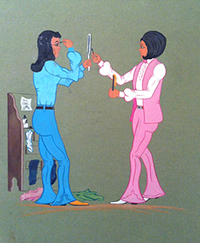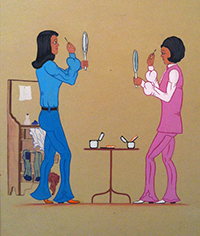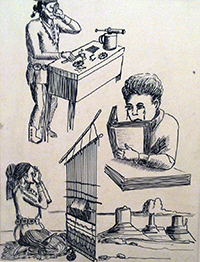




Trachoma Control Program on the Navajo Reservation, 1966, started by the US Public Health Service Indian Medical Center, Gallup. Gift of Dr. B. Alan Kite.
Visualizing History, Then and Now:
Exhibition Subtitle
Recent Acquisitions
Developed over the last 39 years, the C.N. Gorman Museum Collection aligns with the museum's mission to exhibit contemporary artwork by Native American and Indigenous artists. The collection is a vital part of the museum's programs and has steadily grown each year through gifts and selected purchases. The C.N. Gorman Museum has been fortunate to receive several gifts over the last few years, many of which will be on view for the first time.
This exhibition brings together recent acquisitions that reflect and respond to Native American experiences by visualizing social and political histories. Works by prominent Native American and Indigenous artists were selected that document social and political engagement in visual form, from the 1960s and contemporary times.
It is often said that all Native American art, and perhaps existence, can be considered political. The works on exhibit act as documentation, commentary, and interpretation of Native American experience. The Trachoma series from 1966 brings to light an epidemic that continues to be the leading cause of blindess. Within the United States, governmental research and policies were enacted as early as the 1900s, becoming rare by the 1950s, yet the disease remained widespread in Native American communities until the 1970s. Around the same time, Gorman's depiction of hearding horses interprets a more sentimental Navajo experience, however, as an artist, activist and WWII code-talker, Gorman was intwined throughout his life with political involvment.
The works of Lee Marmon and John Miller reflect a lifetime of photographic witnessing and documentation. Marmon's early works on the Laguna Pueblo in the 1940-50s focused upon documenting elders and cultural traditions. However, in his work as official photographer for the Bob Hope classic from 1967-1973, he circulated amongst Hollywood elite, and briefly obtained a White House press pass where he was able to document key politicians. Maori documentary photographer, John Miller, has continued to image activism and protests throughout Aotearoa (New Zealand) since the 1970s, creating a critically important archive of Maori experience.
In the more contemporary pieces, Larry McNeil addresses global climate change in his latest series. In the role of a self-identified "Crow Indian cultural archivist" Wendy Red Star creates work that considers experiences of being a Crow Indian in contemporary society. Shelley Niro looks directly at treaties and languages, while Ron Noganosh satirically considers the engagement of dialogue, created as Dial-Log. In the complex portraiture works by Brenda Croft, Hulleah Tsinhnahjinnie and Mervyn Bishop bring individuals from across time and continents into the exhibition space to create new visual histories as interpreted and contextualized by Indigenous artists.
